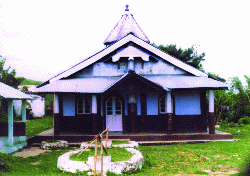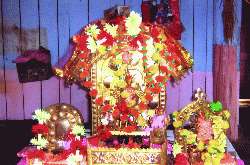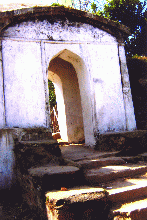Archives
DURGA PUJA -Nartiang
The puja begins with the welcoming of the mother which is followed by three to four days of puja and is concluded with the ritual of immersion. All this is done in accordance with the procedure prescribed in the almanac.
Shree Shree Durga Puja has been performed at Nartiang village for the last 300 to 400 years. Regular puja and the worship of Devi Jayantee is also done at the temple under the governance of the Dolloi. Prior to the Dolloi, all this was done under the patronage of the Jaintia kings, the royal linkage of the kings of Pragyotishpur who were also associated with the sacred of the sacred place of Kamrup Kamakhya.
It is widely believed that years of slavery, ignorance, poverty and lack of communication are the main reasons why the land and the people have remained dormant for so long. In spite of all these problems, Durga Puja has been an annual event that is looked forward to by the people of this village and the surrounding areas; a break from the monotony and hardships of everyday life.
Durga Puja is also known as the Autumn Festival and it continues throughout the whole season. This is a festival that is celebrated throughout the country with due pomp and splendour. At the end of the rainy season, when the ploughing and sowing is completed, the autumn season starts. It is during this period that the people of Nartiang prepare to celebrate the festival.
The people of Nartiang, before the lunar month of Durga Puja, welcome the mother with the beating of drums twice a day, once at dawn and again at dusk which is initianted by the firing of a blank round from a gun. The Dolloi, along with his ministry on a selected market day called ‘Mulong’ starts the function after their assembly. The sound of drumbeats for more than a month makes the temple premises serene.
With the sound of the drumbeats and the firing of the gun which declare the beginning of the celebration, the temple premises and the approach road to the temple are cleaned, grass sods are turned over and lime is spread. The collection of puja ingredients also commences at this time. People wear clean clothes which is a part of the celebration in the family. During this time, most of the locals of Nartiang who have moved to other places return to their ancestral home to take part in the celebration.
During Durga Puja, the idol of the mother on the platform of the temple is taken out and kept in a temporary shed and puja is done here. The image of Devi Durga is made out of young banana plants combined with different other plants, leaves, flower and fruits and is then dressed in new clothes known as ‘Kalabahu’. The image is placed on the same platform inside the temple and puja and worship is done to this Kalabahu. Offerings are also placed before it.
After five to six days of puja, the image is immersed in a particular place in the river Myntary which is reserved for this specific purpose. Another blank round from a gun, the beating of drums, procession of devotees, the singing of devotional songs which is accompanied by music are the norms of  bidding farewell to the mother. The melodious song ‘Maa Ke Bhasaia Jale Dhon Loiea Jaimu Ghorea’ sung by the devotees declares the deep devotion to the universal mother. The people of Nartiang believe that the high theological status maintained by the people of Nartiang in spite of the wretched conditions is the blessing of the mother.
bidding farewell to the mother. The melodious song ‘Maa Ke Bhasaia Jale Dhon Loiea Jaimu Ghorea’ sung by the devotees declares the deep devotion to the universal mother. The people of Nartiang believe that the high theological status maintained by the people of Nartiang in spite of the wretched conditions is the blessing of the mother.
Sacrifice of various animals is also a part of the rituals. Remains of the sacrifice are shared among the family and friends as Prasad. The body of the sacrificial animal is an important protein food for the devotees and they are in need of this as the exertion during the puja requires rich food. All throughout the puja, people pray for peace, prosperity and well being.
Merry making and cultural performances are also a part of the festival as is the lighting of firecrackers and the beating of drums and playing of tambourines.
All the people of Nartiang in general participate in the festival and they are often joined by the people of the entire Jainta Hills. The Dolloi of Nartiang, on behalf of the Dolloi and the people perform the puja. The twelve Jaintia Dollois send their respective sacrificial goats to Nartiang as a token of their participation. Till date, one ram is sacrificed to the mother which is arranged by the Dolloi of Nartiang in the name of all Jaintia Dollois and the people of the Jaintia Hills. The Dolloi of Nartiang, head of the eleka, shoulders all the responsibility of maintaining the sacred place and its practices. The Dolloi along with his ministry all perform their respective duties during the puja. The devotees pray, offer their offerings and pay obeisance to the mother. The priest then puts a mark of vermillion on the forehead of the devotee as a mark of the manifestation of the devotion. The ruits and corn brought by the devotee are offered to the mother. A part is kept by the priest and the remains are taken back home to be shared among family and friends.
The traditional system of maintaining the socio, cultural and religious rich heritage of Nartiang is unique. The system is confined within the land and the people of Nartiang and is sovereign in nature. The imparting of education, maintenance of the sanctity and nourishment of the sacred of sacred place of Nartiang is the responsibility of all.
There are reserved lands for particular purposes. The land is allotted for a certain period of time to an eleka man. In return, he is to do the work and meet the expenses of the rites and rituals. There are also reserved and sacred forests for sacrificial fuel, firewood and construction materials.
The chronological worship of Ardhana, Bodhona, Shasti, Saptami, Ostomi, Sandhi, Novomi, Dasami, Bishjans, Bijoya Sanmilon, etc is done systematically. The traditional dance in royal dress of the Dolloi and his ministry in the midst of a gathering of the people proves the performance of puja in peace. This is also a social meet and gathering of the people of Nartiang. Distillation of wine for relatives and friends during the festival is also a tradition in the eleka.
performance of puja in peace. This is also a social meet and gathering of the people of Nartiang. Distillation of wine for relatives and friends during the festival is also a tradition in the eleka.
Singing devotional songs which are kept in rhythm by musical instruments such as the ‘khool’ and ‘kartal’ during the puja and festival is also traditional. Different songs are sung on different occasions. The songs are in colloquial Bangla derived from Sanskrit. The songs and sacred hymns are not in written form and are maintained through memory and handed down from generation to generation orally. Hence some lines and words have been lost or omitted and this is due to the omission of Bangla or Devonagi scripts from the literature. Nevertheless, the sweet tunes sung by the women at intervals during the puja are a sign of well being and joy.
On the puja days, devotees come to the temple after bathing and they wear clean clothes. They bring with them eatables from home to offer to the mother. Normally, the mother of the house offers the offering and prays for the well being of the family.
The purity and sanctity of the shrine is always maintained by the people of Nartiang. They do not spit in or desecrate the premises.The shrine remains closed during odd hours and during Ambubachi, it remains closed for three to four days as is observed in Devi Tirtha Kamrup Kamakhya.
It is needless to say that the temple at Nartiang has withstood the test of time. It has had its fair share of problems. In the past, it was almost completely destroyed by a storm but was reconstructed in 1987 at a cost of Rs. 1, 75,000 within a period of four months. This temple has become an integral part of Nartiang village, in fact, one can go so far as to say that it is the heart and soul of Nartiang village, a source of peace, prosperity, hope and comfort to the villagers and a marvel to wonder about for outsiders.

